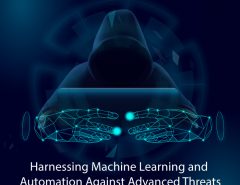A key buzzword in today’s inter-connected digital landscape is “machine learning”. The concept basically refers to computers learning from data instead of receiving explicit programming. Through such machine learning algorithms, computers are fed huge datasets and parse through them to recognize patterns or co-relations through extended data analysis.
Machine learning is becoming a common feature in more and more industries and cybersecurity has not lagged behind. An ABI Research estimated that machine learning in cybersecurity will boost big data, intelligence and analytics spending to $96 billion by 2021. It is quite clear why there is such extended growth – machine learning allows business to offer a better response and bolster their own defense when it comes to the big, bad world of cyber threats. Security companies are rejigging the solutions they offer in tune with this trend. They are moving from signature-based systems to layered solutions where machine learning systems interpret data to better detect malware.
Machine learning tasks are categorized into three types: 1) Supervised Learning where labelled data is used to train a model which can be later applied to unseen data to label it, 2) Unsupervised Learning where unlabeled data is used for training to discover patterns or a structure in the input data and 3) Reinforcement Learning where a punishment-reward method is used for learning.
There are several places where machine learning plays a key role in cybersecurity. Some of them are:
Creating cluster samples
A key outcome of machine learning is cluster samples, or dividing datasets in a way that similar samples have their own groups. Basically, groups are segregated according to their traits and then assigned into clusters. These clusters are then re-clustered at intervals to accommodate newer samples in a process called incremental clustering. Machine learning algorithms like Centroid Models, Distribution Models and Density Models are used for this purpose.
Identifying Samples
Machine learning is used to aggregate and analyze large-scale data such as the above-mentioned cluster samples to automate the process of classification. Seqrite’s automated malware classification system labels this data as malicious or not through the contextual information garnered. Through this extensive process of data mining, samples can be easily distinguished as malicious or benign which is called sample classification.
Read more: Machine learning approach for advanced threat hunting
Creating a Deployable Detection Model
The above two process play their part to create a Deployable Detection Model. It is important to select the right set and ratio of benign and malware samples, train and test the selected set and select a correct algorithm for the same. However, they are not immediately deployed at endpoints – they are judged on parameters such as size, time required to generate said model, time taken by model to scan a sample, quality of model, false positive ratio, etc. It is only after extensive testing that they can be considered for endpoint deployment.
Operating in passive mode initially and observing detection patterns, these models are also supported by Seqrite’s cloud security platform. Automated systems in the cloud analyze the telemetry generated by these passive models and based on their finds, this models may be made active.
While Machine Learning represents an exciting new investment, it is important not get carried and believe that it is the solution for all cybersecurity woes. The world of cyber threats is constantly evolving and sometimes even machines may not be able to keep up. To put all trust in machine learning algorithms would be a wrong idea – what should be the best way forward is to use machine learning algorithms as a tool to bolster cybersecurity defense, along with data science and human expertise.
As an IT security partner for your business, Seqrite provides comprehensive security from advanced cyber threats. To know more


